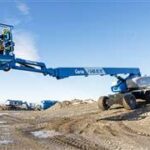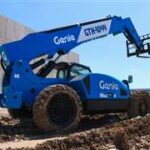You’re cruising across a jobsite in a massive boom lift.
The next site is just a few blocks down the road.
You’re thinking…
“Can I just drive this thing there?”
Spoiler: it’s complicated.
Let’s break down when you can, when you can’t, and why “just rolling down Main Street” in a boom lift might not be the brightest idea.
🛻 Quick Answer: Usually Not
In most regions, boom lifts are NOT street legal for normal road travel.
They’re classified as off-road equipment, not motor vehicles.
Why?
Because boom lifts:
-
Aren’t designed for highway speeds (5 mph isn’t gonna cut it)
-
Lack road-required safety features (headlights, turn signals, seatbelts)
-
Aren’t crash-tested like cars or trucks
-
Have tires meant for job sites, not asphalt longevity
Driving a boom lift on a public road without permits = big fines (and even bigger insurance nightmares).
⚙️ What About Crossing Roads?
✅ Short, supervised crossings across streets can be allowed under certain conditions:
-
With proper traffic control (flaggers, cones, signage)
-
Within defined construction zones
-
If local regulations allow temporary road usage
In these cases, the lift isn’t “traveling on public roads”—it’s briefly crossing under controlled conditions.
But random “casual cruising” to your next job?
Nope.
📜 Permits & Legal Loopholes
Some local jurisdictions allow limited boom lift street use with special permits.
Common permit requirements:
-
Restricted speed limits (often below 15 mph)
-
Mandatory warning lights and reflective tape
-
Escort vehicles (pilot cars)
-
Strict route approvals
-
Only during off-peak traffic hours
Even then, it’s often cheaper, faster, and safer to transport the lift on a trailer or flatbed truck.
🛻 How to Move a Boom Lift Legally and Smartly
When you need to shift a boom lift from one site to another across real distances:
-
Use a lowboy trailer or flatbed truck
-
Secure the machine using approved tie-down points
-
Follow weight and height restrictions for your route
-
Check for overpass clearances if the boom is tall, even when folded
Most heavy equipment haulers have boom lift transport down to a science—and the fees are way less than paying a fine (or paying for road damage repairs).
🚧 Special Cases: Self-Propelled Lifts on Private Roads
If you’re working inside:
-
An industrial park
-
An airport
-
A private campus
… and the roads are privately owned, you may have more flexibility.
Still, check with site safety teams.
Private doesn’t mean anything-goes.
You might still need:
-
Spotters
-
Warning signage
-
Speed restrictions
Because whether it’s private or public, accidents don’t care about property lines.
🚨 Risks of Driving Without Permission
-
Heavy fines (thousands of dollars)
-
Points on your driver’s license (in some states)
-
Equipment impoundment
-
Insurance claim denials if an accident occurs
-
Public relations disaster (“Contractor drives boom lift into Starbucks patio”)
Not exactly great for your career—or your Instagram.
🧠 Common-Sense Summary
| Scenario | Street-Legal? |
|---|---|
| Normal city street | ❌ No, use a trailer |
| Crossing street in job zone | ✅ Yes, with supervision |
| Private industrial road | ✅ Maybe, check policies |
| Driving to lunch break | ❌ Definitely not |
Boom lifts belong in the air, not the fast lane.
🏁 Final Thoughts
So—are boom lifts street legal?
👉 Usually no.
👉 Sometimes maybe (with permits, escorts, and lots of paperwork).
👉 Always safer to haul them properly.
Bottom line:
When it’s time to move, use a trailer, not the sidewalk.
Boom lifts are amazing at lifting people—not dodging traffic.
Lift safe.
Drive smarter.
Stay off Main Street.





